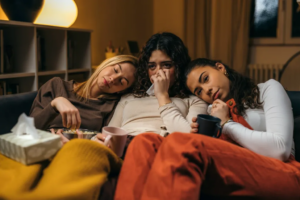Under new repatriation rules, museums must gain consent from Native American tribes before displaying their cultural items. Some museums rushed to comply, but others, such as the Museum of Us and History Colorado, were prepared to meet the moment.
ProPublica is a nonprofit newsroom that investigates abuses of power. Sign up to receive our biggest stories as soon as they’re published.
As major U.S. museums in recent weeks closed displays and exhibit halls containing Native American objects, the Museum of Us in San Diego hasn’t done the same.
That’s not because the anthropological museum is ignoring new federal repatriation rules, which took effect this year. Rather, more than five years ago, its board of trustees adopted a policy on collections from Indigenous communities that addressed the concerns the new rules focus on.
In its policy, the Museum of Us admitted it had blocked the repatriation of items and excluded Indigenous perspectives in exhibits centered on the groups’ cultures. It also acknowledged that it had failed to link the collecting practices it embraced after its founding in 1915 to the history of genocide against Native Americans.
“We’re not scrambling,” Kara Vetter, the Museum of Us’ senior director of cultural resources, said of the new regulations. “It doesn’t really change anything for us.”
The fact that the Museum of Us addressed its collections years ago stands in sharp contrast to the American Museum of Natural History in New York, which shuttered two exhibit halls where items from tribes in the northern U.S. were displayed. Harvard University’s Peabody Museum and the Metropolitan Museum of Art in New York also have removed select items from display. And Chicago’s Field Museum has shrouded dozens of display cases in its ancient Americas, northwest coast and arctic exhibits.
Each of those museums say they are prioritizing repatriations under NAGPRA and the perspectives of tribes. They also have removed items from display in the past in response to requests from tribes but are now closing or covering displays as they review information about the items and meet the mandates of the new federal regulations.
ProPublica is a nonprofit with one mission: Produce deep-dive, well-researched, nonpartisan journalism that spurs real-world change. And we have a great track record. Over the years, our reporting has resulted in new laws being passed, innocent people freed from prison, and people in power resigning. We rely on readers to fund our work. Join over 50,000 members and make a tax-deductible donation today.
Founding displays at many of the country’s older museums reflected the once-widespread, racist view held by many white anthropologists and early archaeologists that Native Americans were an inferior and dying race of people whose ancestors needed to be studied and preserved.
Under the 1990 Native American Graves Protection and Repatriation Act, institutions are required to provide summaries of their holdings to tribes and federal officials — which then allows tribes or descendants to begin the process of reclaiming the items or their ancestors’ remains. In a series of articles last year, called “The Repatriation Project,” ProPublica reported how today, hundreds of institutions still hold the remains of over 97,000 Native Americans, along with tens of thousands of belongings that were buried with them.
Because museums have been so slow to relinquish hundreds of thousands of objects — often obtained generations ago through exploitative purchases or grave looting — they now face a new mandate to again consult with tribes about the items they still have, including those on display.
The rules mandate that museums have a “duty of care” to defer to tribes’ requests and customs in handling their ancestors and belongings in storage facilities. They also require the consent of tribes in order to exhibit cultural and funerary items.
While closures at some high-profile museums made headlines, other institutions like the Museum of Us and History Colorado, a publicly funded network of museums, had no need to scramble because they had already taken measures to work with tribal nations in deciding what items should be displayed and how.
“This is just a little piece of what NAGPRA is about, and if institutions were doing what they were supposed to do, this is not what they would have to do today,” said Shannon O’Loughlin, an attorney and chief executive of the Association on American Indian Affairs. “They would have already repatriated and educated the public more appropriately about who Native people are.”
Under the policy adopted in 2018, Museum of Us staff must obtain documented authorization from tribal communities to continue housing tens of thousands of items in its collections. And no items subject to NAGPRA, such as items taken from graves, are to be displayed. Museum leaders’ meetings with Indigenous people about the collection are expected to foster new exhibits that tell authentic and nuanced stories, according to its policy.
Today, the museum is years into a process that’s now mandated by the new NAGPRA regulations.
It has transferred items to tribes that request them. But it has also found that some tribes want items made by their ancestors to stay at the museum — such as several baskets from the Jamul Indian Village, 20 miles east of San Diego.
At History Colorado, curators also have not had to remove objects from exhibits or cover displays since the rules took effect. Founded as the state government’s historical society in the late 1800s, it has already returned to tribes all items and human remains subject to NAGPRA.
Today, History Colorado’s museums continue to present exhibits about tribes and their histories, but collaboration with tribal representatives who help make decisions about displays is now a “guiding virtue,” said Dawn DiPrince, History Colorado’s CEO and president. “Some of this really is about where authority is held and whose knowledge should come to bear. This is something that we deal with in the creation of exhibitions and materials in our collections.”
History Colorado improved its collaboration with tribes following a painful episode more than a decade ago in which the museum opened and promptly closed an exhibit on the Sand Creek Massacre. More than 230 Cheyenne and Arapaho people were murdered on the plains of eastern Colorado in the 1864 attack, and tribes have long told of how the trauma caused by the massacre has persisted among Cheyenne and Arapaho people for generations. Yet tribal representatives were excluded from the planning of the 2012 exhibit, “Collision: The Sand Creek Massacre, 1860s to Today,” which showcased weapons.
Tribes were immediately critical, pointing out that the exhibit’s title suggested the massacre was a two-sided battle when the tribes had not sought a confrontation with the U.S. government, whose troops killed women, children and elders at Sand Creek. They also noted the insensitivity of displaying weapons, DiPrince said.
Following years of talks, History Colorado began to work directly with tribal members on exhibits — first on one about Ute tribal nations that opened in 2018 and then a new exhibit on the Sand Creek Massacre, which opened in 2022, without items from the massacre site.
“Tribal reps and staff weighed every single word in that exhibition,” DiPrince said. “The belongings that are on exhibit were also selected by them.”
Chance Ward, History Colorado’s NAGPRA coordinator who is Lakota and a citizen of the Cheyenne River Sioux Tribe, said that the state historical society also now accommodates tribal members’ requests for access to objects that are on display. For example, a ceremonial staff with eagle feathers in the Sand Creek exhibit is still used by the tribes, including during an annual healing run at Sand Creek Massacre National Historic Site. Afterward, tribal members return the staff to the exhibit, where text explains what it was used for in the past and how it is still used today.
“That’s a great example of what exhibits should reflect in all museums, that tribes are still alive and they still use modern contemporary items in their culture and for ceremonies and it’s not just black and white photos of us,” said Ward, who joined History Colorado in September.
He said History Colorado updated its repatriation policy this month to ensure its museums continue honoring tribes’ wishes, especially when a tribe initially consents to the museum possessing or displaying an object but later wants it to be returned.
“Consent today does not equal consent in the future,” the museum’s updated policy states. “Consultation with Native American and Indigenous Peoples on how to present their histories is an ongoing process that cannot be rushed.” The Museum of Us’ policy uses similar language.
It’s important for museums to acknowledge their past, said Elysia Poon, director of the Indian Arts Research Center at the School for Advanced Research in Santa Fe, New Mexico. Poon said she’s noticed over the past decade more museums are trying to work with tribes, but leadership’s involvement is a key factor in whether that happens.
Last year, she and a group of colleagues from tribal museums, culture centers and other institutions published new industry standards, calling for more deference to Native traditions and knowledge when displaying and storing Native American items. The standards inform the museum accreditation process through the American Alliance of Museums but are not formal criteria, Poon said, adding that their hope is to address the need for greater cultural competency and sensitivity within institutions.
“These are issues that have long been identified as problems with museum structures,” Poon said. “The structures are colonial inherently.”
When NAGPRA passed in 1990, Sen. Daniel K. Inouye of Hawaii acknowledged that reality, telling members of Congress, “For museums that have dealt honestly and in good faith with Native Americans, this legislation will have little effect.”
But for museums that have “consistently ignored the requests of Native Americans,” he said, “this legislation will give Native Americans greater ability to negotiate.”




